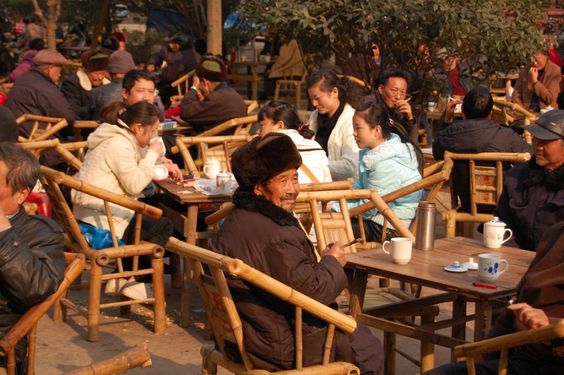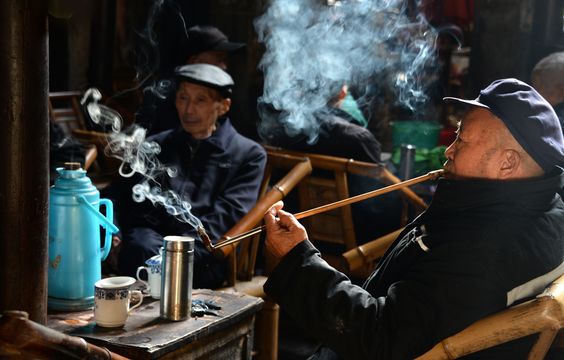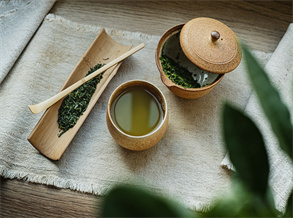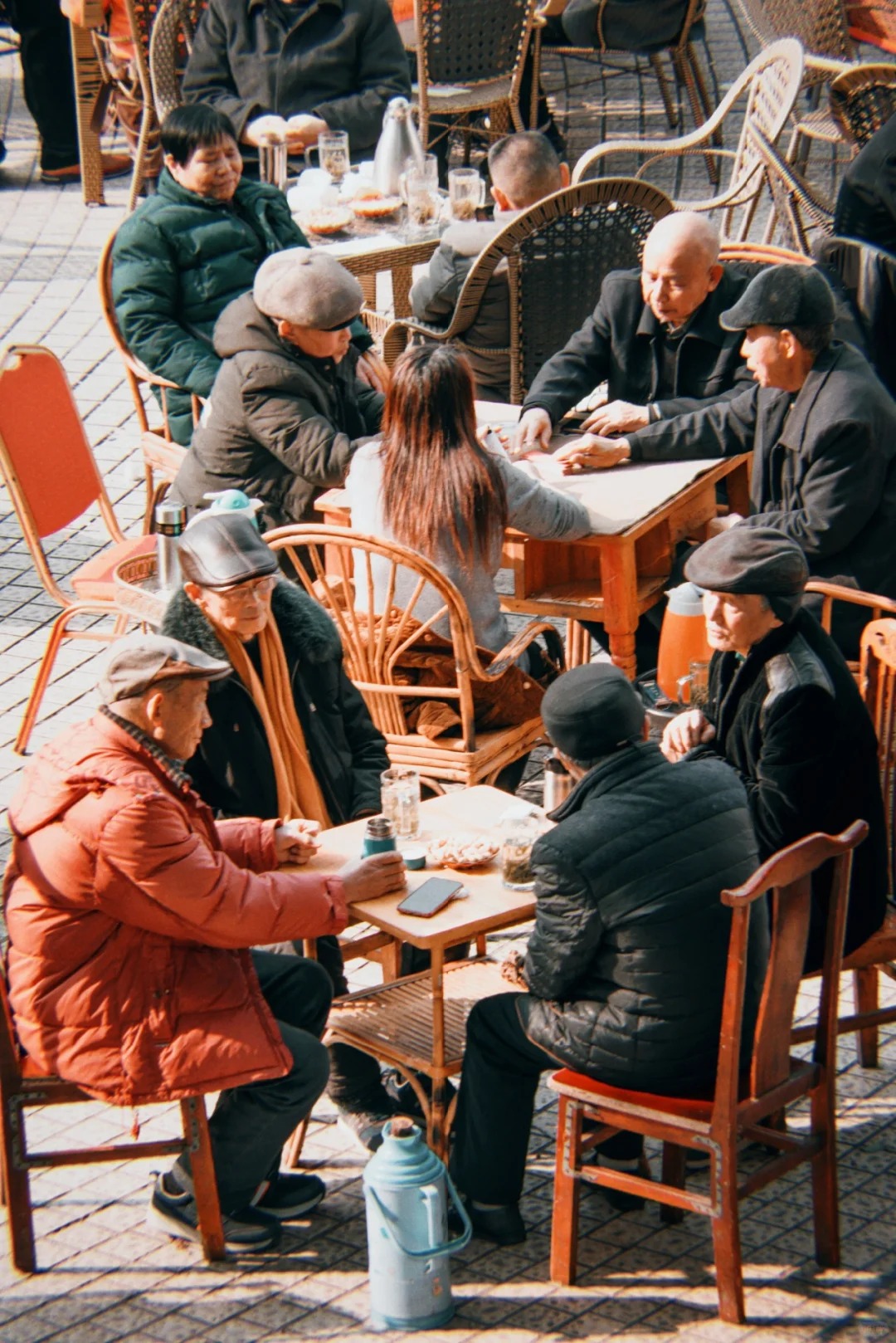Why go to a tea house to make stews and boils? This involves the issue of fuel. Nowadays it's either electricity or natural gas, when we were kids it was honeycomb coal, and then earlier it was wood burning, and coal is expensive, as is wood. The Chengdu Plain, due to thousands of years of development, there is not much forest around, such a large city, the fuel supply is insufficient, expensive, so the average family in addition to cooking usually do not have a fire, boiling medicine, stew meat is very expensive, farmers usually use beanstalks, wheatgrass to cook, cooking a meal needs to be burned a large pile of grass. 1970's, I was in the Meishan countryside, the burning of all the cereal grass, a room of cereal grass can not burn for a long time. Although Chengdu is located in the south, but the average person in the winter is not good, indoor and outdoor as cold, and wet, and there is no fire-roasting equipment, a big reason is that the fuel is expensive and lack of. So in the past, some people, even to wash their faces to the tea house to buy hot water, because it is not cost-effective to burn their own. Shading has written a lot of Sichuan's vernacular literature novels, one is called ‘morning tea drinkers’, which is very detailed description of tea drinkers, early in the morning before dawn, get up and go out to drink morning tea, drink a good time and then call the hall keeper to hit the hot water to wash their faces. The lack of fuel is closely related to people's lifestyles, which is why Chengdu residents are particularly dependent on tea houses.
Why are there so many tea houses in Chengdu? It is the result of a combination of factors. None of the factors mentioned just now exist in Chengdu anymore. Fuel, water, roads, and the diaspora are all conditions that contributed to the development of the tea house, but why are there still so many tea houses in Chengdu? I have answered this question in tea houses: The Decline and Revival of Public Life in Chengdu, 1950-2000, a book soon to be published by Peking University Press, so you can find out the answer for yourself.

How to understand the tea houses of the past?
The audience here must be thinking: you say there is no information for researching tea houses, so how do you know what happened to tea houses? No one else knows why you know, and why you boast that you are the person in the world who knows the most about Chengdu's tea houses. I will answer this question now, how to understand the tea houses of the past.
In 2002, I received a National Humanities Research Fellowship in the United States, and Western academics took our Chengdu tea houses very seriously. At that time, I really had no confidence - if I were to apply for a research project on tea houses in China, I wouldn't even be sure to get a grant, because most likely the reviewers wouldn't think there would be much value in the research. Thanks to this research grant, it allowed me to stay in Chengdu for a year from 2002 to 2003 to conduct research and study.
I have been doing fieldwork since 1997, apart from going to archives and libraries, there are also the various tea houses in Chengdu, the most upscale Sentosa, the low-grade tea houses for a few cents, and the video halls, where they are all filled with migrant workers, students, unemployed people, etc. For 5 yuan, apart from tea, you can watch Hong Kong martial arts films for a day, and video halls were very popular around 2000.

Where does the main source of information for historians come from?
Mainly from various documents, archives, etc. The Chengdu Municipal Archives has collected quite a lot of very precious archives. If you go to the Chengdu Municipal Archives and say that you want to look at the archives of the tea house, there is absolutely no way, and the staff will tell you: we don't have any archives about the tea house. In fact, you have to dig in the middle of the vast amount of information. Where are the archives of tea houses located? The records of the Chamber of Commerce, the records of the Tea Houses Association, the records of the business register - because you have to register to open a tea house - and the records of the police station, why? Because disputes and fights may occur in a tea house, smashing up the tea house or causing casualties, and the police will intervene, and the files on how these cases are handled are kept; and there are also the local newspapers, which report on what happened and what regulations the government announced, such as hygiene, prices, and so on.
Republic of China on the tea house control is still quite strict, to increase the price of tea first to the Tea Society Industry Association through, through the government after the report, for example, a bowl of tea from 10 cents to 12 cents, not the tea house want to go up, but also through the government. Price increase involves a series of issues, why do you want to go up, to state the reasons, such as how much the fuel has increased, how much the tea has increased, how much the labour has increased, if the tea does not increase the price will lose money, and so on. These statements were kept. Although it was said to be for the matter of tea price increase, a lot of potentially useful information was actually recorded. Some of you here are undergraduates or postgraduates. If you want to do research, you must think about what other hidden things you can find between the lines from the events recorded on the surface. For example, from the above statement, one will find out how the tea house operates, what percentage fuel accounts for in the cost of the tea house, how much tea leaves account for in the cost of the tea house, how much labour accounts for, and all these are in there. Although it talks about the tea house price increase, it provides a lot of other information.
What was the tax rate that tea houses paid in the Republican era? 2%. I think it was a relatively low percentage of the cost. How much of the cost is fuel? Almost 50%. Fuel was really too expensive in the Chengdu plain. It is reasonable to say that the proportion of tea in the tea house business should be higher, but the actual tea only accounted for less than 20% of the cost. Rent was very cheap at that time, according to various sources, rent accounted for only about 5% of the cost, not expensive at all. From the archives, we can decipher a lot of information.
Business registration, such as having to report to the government what the name of the manager of the tea house was, what the name of the person who mixed the tea was, how many people were employed, and even how much they were paid, all these archives provide us with valuable information to understand the tea house. In the past, there were quite a few articles about Chengdu tea houses, but because they did not dig into the deeper information, they were not detailed. We don't know exactly how Chengdu tea houses were run, whether they made money or not, and how much they invested. So this kind of statistics and surveys provide very good and concrete information.
The three histories of tea houses

Just now I said that the daily life of the tea house is not a big issue about the national economy and people's livelihood, nor is it a big topic like war or dynasty change, but what can we find out from our research on tea houses, whether it's on Chengdu's tea houses or on tea houses in other cities? In my book The tea house, I actually wrote about three kinds of tea house history.
One is the economic history of the tea house. tea houses were small businesses, not big businesses. What was the place of small businesses in the city's economy? Chengdu didn't have any big industries before 1949, and most of them were small businesses, small shops, small workshops. However, there is a lack of research on how small businesses operated, their capital, profits and losses. Through the study of Chengdu tea houses, we know the economic history of tea houses and understand the economic operation of the city.
The second is the social history of the tea house. The life of the tea house is actually the social history of the tea house. Every day, so many people go to the tea house to drink tea, and all kinds of complicated relationships occur between people, and they are talking about all kinds of topics, which is a kind of social space, information exchange space, and can understand the relationship between people. This is what I took in the old tea house of Guanyinge in Pengzhen a few years ago, where people were playing cards, chatting, and there was a close relationship between people. This pattern is hard to see in Chengdu city, and this traditional way of life can still be found in places a little bit on the edge.
The third is the political history of tea houses. The first two questions are not surprising, but how did tea houses become associated with politics? I'll give you some specifics in a moment, and you make the judgement to see if the tea house was a political arena.
The tea house as economic history has already been mentioned earlier, so I won't talk about it here; let's look at it as social history first. There were all sorts of social activities in the tea house, in which people exchanged information, and gambling often took place in the tea house. When you are happy, you are given a face and you are expected to leave quickly.

